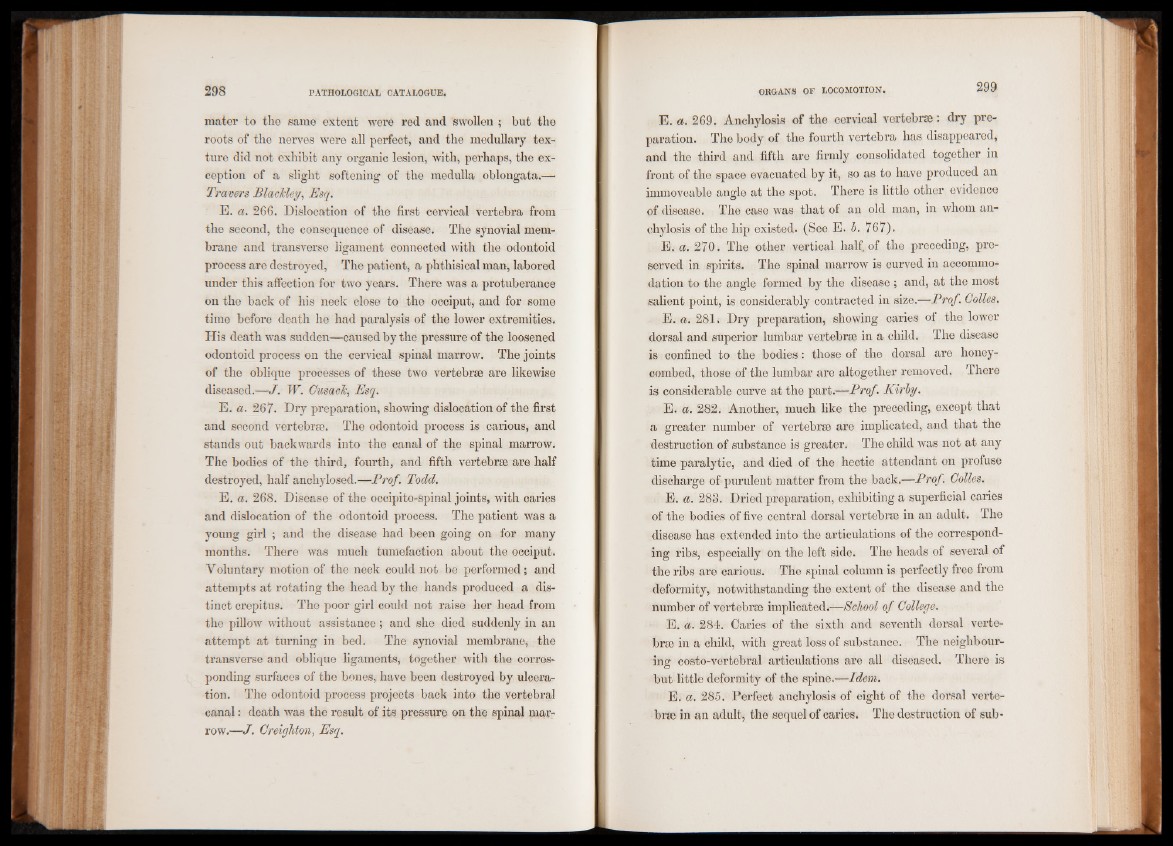
mater to the same extent were red and swollen ; but the
roots of the nerves were all perfect, and the medullary texture
did not exhibit any organic lesion, with, perhaps, the exception
of a slight softening of the medulla oblongata.—
Travers Blackley, Esq.
E. a. 266. Dislocation of the first cervical vertebra from
the second, the consequence of disease. The synovial membrane
and transverse ligament connected with the odontoid
process are destroyed, The patient, a phthisical man, labored
under this affection for two years. There was a protuberance
on the back of his neck close to the occiput, and for some
time before death he had paralysis of the lower extremities.
His death was sudden—caused by the pressure of the loosened
odontoid process on the cervical spinal marrow. The joints
of the oblique processes of these two vertebra; are likewise
diseased.—J. W. Cusack, Esq.
E. a. 267. Dry preparation, showing dislocation of the first
and second vertebra. The odontoid process is carious, and
stands out backwards into the canal of the spinal marrow.
The bodies of the third, fourth, and fifth vertebrse are half
destroyed, half anehylosed.—Prof. Todd.
E. a. 268. Disease of the oceipito-spinal joints, with caries
and dislocation of the odontoid process. The patient was a
young girl ; and the disease had been going on for many
months. There was much tumefaction about the occiput,
Voluntary motion of the neck could not be performed; and
attempts at rotating the head by the hands produced a distinct
crepitus. The poor girl could not raise her head from
the pillow without assistance; and she died suddenly in an
attempt at turning in bed. The synovial membrane, the
transverse and oblique ligaments, together with the corresponding
surfaces of the bones, have been destroyed by ulceration.
The odontoid process projects back into the vertebral
canal: death was the result of its pressure on the spinal marrow.—
J. Creighton, Esq.
E. a. 269. Anchylosis of the cervical vertebra: dry preparation.
The body of the fourth vertebra has disappeared,
and the third and fifth are firmly consolidated together in
front of the space evacuated by it, so as to have produced an
immoveable angle at the spot. There is little other evidence
of disease. The case was that of an old man, in whom anchylosis
of the hip existed. (See E. b. 767).
E. a. 270. The other vertical half, of the preceding, preserved
in spirits. The spinal marrow is curved in accommodation
to the angle formed by the disease ; and, at the most
salient point, is considerably contracted in size.—Prof. Colles.
E. a. 281, Dry preparation, showing caries of the lower
dorsal and superior lumbar vertebra in a child. The disease
is confined to the bodies: those of the dorsal are honeycombed,
those of the lumbar are altogether removed. There
is considerable curve at the part.—Prof. Kirby.
E. a. 282. Another, much like the preceding, except that
a greater number of vertebra are implicated, and that the
destruction of substance is greater. The child was not at any
time paralytic, and died of the hectic attendant on profuse
discharge of purulent matter from the back.—Prof. Colles.
E. a. 288. Dried preparation, exhibiting a superficial caries
of the bodies of five central dorsal vertebra in an adult. The
disease has extended into the articulations of the corresponding
ribs, especially on the left side. The heads of several of
the ribs are carious. The spinal column is perfectly free from
deformity, notwithstanding the extent of the disease and the
number of vertebra implicated.—School of College.
E. a. 284. Caries of the sixth and seventh dorsal vertebra
in a child, with great loss of substance. The neighbouring
costo-vertebral articulations are all diseased. There is
but little deformity of the spine.—Idem.
E. a. 285. Perfect anchylosis of eight of the dorsal vertebra
in an adult, the sequel of caries, The destruction of sub